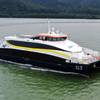Bay Marine, Inc., a Barrington, RI Naval Architecture company, recently completed their a technologically advanced ship design. Company president, Dave Bonney, recently explained the long design process and the details of this new ship, the R/V Hugh R. Sharp.
The Sharp was delivered to its operator/owner, the University of Delaware last week. It is a 146 ft. oceanographic research vessel with numerous technological advancements. She replaces the nearly 30 year old R/V Cape Henlopen.
Bay Marine has been working with the University of Delaware since 1995. They began the design of the new vessel in 2001. The University embarked on a very careful design process wherein they investigated all options for their new vessel. Bay Marine developed a concept design first. Then a more detailed, preliminary/bid design was completed and sent to shipyards around the country. Finally, Bay Marine created the construction design with details for construction and approval by the American Bureau of Shipping. Bay Marine was also involved with supervision of construction.
The vessel has numerous unique features.
The vessel was specifically designed to have a low radiated noise signature. The public is most familiar with vessels of this type from the military. In the Navy it is imperative that your ship not make noise because it can be tracked and/or targeted if it does.
The Hugh R. Sharp has a low radiated noise signature for a different purpose. A small class of research ships in the world have been designed and built in the past 15 years specifically to do fisheries research. The United Kingdom has several of these vessels as does Norway. The United States has been the last of the large industrialized countries to get on board with this new technology.
The intent behind the low radiated noise signature is that if the ship is extremely quiet – then highly sensitive electronic equipment (and software) can be used to “count” the fish in the sea. As opposed to the old methods of doing small trial trawls to assess stocks, this methodology allows for faster and more frequent surveys. At this time – the science is still developing – and the scientists still do trawls to “ground truth” the electronic census. As these methods mature – the fisheries researchers may be able to do the studies without dipping a net in the water.
A standard for just how quiet the vessel must be was developed in 1990. An international committee of scientists developed what has become known as the ICES standard. (ICES is the International Council for the Exploration of the Seas).
Fish stocks all over the world are under intense pressure. Those of us involved with the commercial fishing industry (especially the fishermen) realize how imperfect our science has been in the past. Most parties would agree, from the fishermen, to the scientists to the environmentalists – we do need better fish stock assessment. Better tools like the SHARP can only improve the science and the results.
Featured videos

Unlock Onboard Data Efficiencies

Inmarsat Enhances Service to Drive Digitalization

Tracking Foreign Vessels Working in the U.S. Jones Act Market
Subscribe for
Maritime Reporter E-News
Maritime Reporter E-News is the maritime industry's largest circulation and most authoritative ENews Service, delivered to your Email five times per week








